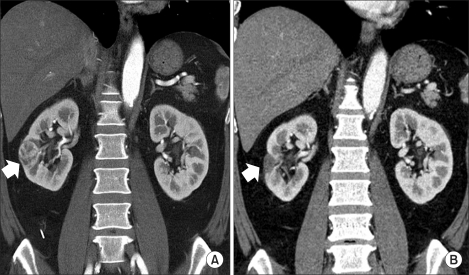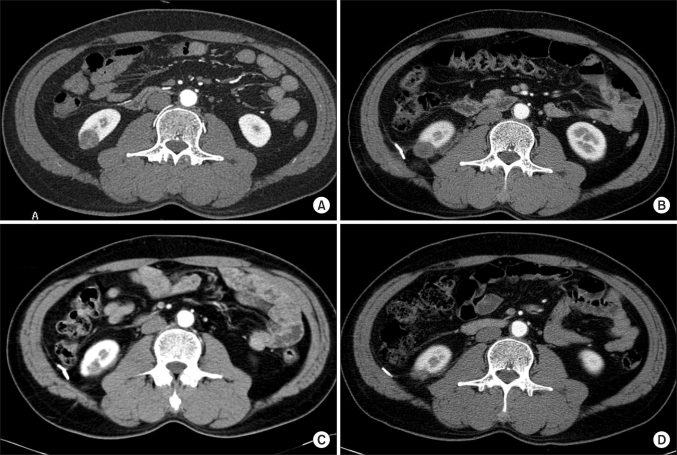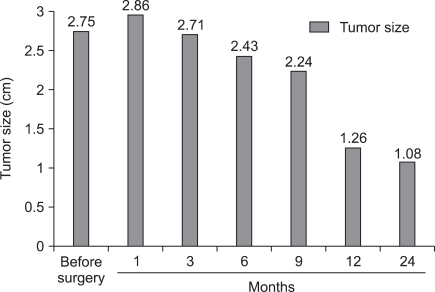Korean J Urol.
2010 Aug;51(8):518-524. 10.4111/kju.2010.51.8.518.
Cryoablation for Endophytic Renal Cell Carcinoma: Intermediate-Term Oncologic Efficacy and Safety
- Affiliations
-
- 1Department of Urology, Korea University School of Medicine, Seoul, Korea. mdksh@korea.ac.kr
- KMID: 1997018
- DOI: http://doi.org/10.4111/kju.2010.51.8.518
Abstract
- PURPOSE
To evaluate the efficacy and safety of laparoscopic renal cryoablation (LRC) of small endophytic renal cell carcinoma, for which surgical treatment is technically difficult.
MATERIALS AND METHODS
We enrolled patients with endophytic tumors from a prospectively collected database of 45 renal tumors in 39 patients who had undergone LRC from June 2005 to May 2009. An endophytic tumor was defined as less than 40% of the lesion extending off the surface of the kidney. We evaluated surgical and oncological outcomes.
RESULTS
Among the treated tumors, 17 tumors (37.8%) were defined as endophytic tumors and 15 tumors from 14 patients were confirmed as renal cell carcinoma (RCC) in the pathologic examination of the tissue biopsy that was conducted at the time of LRC. The mean American Society of Anesthesiologists (ASA) score of the whole patient group was 2.9 (range, 1-4), and 85.7% (12/14) of the patients had an ASA physical status score over 3. The mean tumor size was 2.8 cm (range, 1.7-3.7 cm). The layout of the cryoprobe was carefully planned preoperatively on the basis of radiologic evaluation in all tumors. Multiple cryoprobes (mean, 3.2; range, 2-5) were used. No major complications, including open surgical conversion and nephrectomy due to bleeding, occurred. No patient experienced clinical symptoms of collecting system injuries. During the mean follow-up of 32.6 months (range, 12-51 months), radiologic evidence of tumor recurrence was found in one patient (6.7% for RCC). With the exception of this patient, all other patients have remained free of recurrence or metastasis, as determined by periodic radiologic workups.
CONCLUSIONS
In this series of patients with intermediate-term follow-up, LRC for endophytic renal cell carcinoma showed acceptable oncological and surgical outcomes without sequelae in the collecting system.
MeSH Terms
Figure
Reference
-
1. Hafez KS, Novick AC, Butler BP. Management of small solitary unilateral renal cell carcinomas: impact of central versus peripheral tumor location. J Urol. 1998; 159:1156–1160. PMID: 9507821.
Article2. Frank I, Colombo JR Jr, Rubinstein M, Desai M, Kaouk J, Gill IS. Laparoscopic partial nephrectomy for centrally located renal tumors. J Urol. 2006; 175:849–852. PMID: 16469563.
Article3. Venkatesh R, Weld K, Ames CD, Figenshau SR, Sundaram CP, Andriole GL, et al. Laparoscopic partial nephrectomy for renal masses: effect of tumor location. Urology. 2006; 67:1169–1174. PMID: 16765174.
Article4. Reisiger K, Venkatesh R, Figenshau RS, Bae KT, Landman J. Complex laparoscopic partial nephrectomy for renal hilar tumors. Urology. 2005; 65:888–891. PMID: 15882717.
Article5. Brashears JH 3rd, Raj GV, Crisci A, Young MD, Dylewski D, Nelson R, et al. Renal cryoablation and radio frequency ablation: an evaluation of worst case scenarios in a porcine model. J Urol. 2005; 173:2160–2165. PMID: 15879879.
Article6. Warlick CA, Lima GC, Allaf ME, Varkarakis I, Permpongkosol S, Schaeffer EM, et al. Clinical sequelae of radiographic iceball involvement of collecting system during computed tomography-guided percutaneous renal tumor cryoablation. Urology. 2006; 67:918–922. PMID: 16698352.
Article7. Cestari A, Guazzoni G, dell'Acqua V, Nava L, Cardone G, Balconi G, et al. Laparoscopic cryoablation of solid renal masses: intermediate term followup. J Urol. 2004; 172:1267–1270. PMID: 15371821.
Article8. Stein RJ, Kaouk JH. Renal cryotherapy: a detailed review including a 5-year follow-up. BJU Int. 2007; 99:1265–1270. PMID: 17441921.
Article9. Forrest JB, Rehder K, Cahalan MK, Goldsmith CH. Multicenter study of general anesthesia. III. Predictors of severe perioperative adverse outcomes. Anesthesiology. 1992; 76:3–15. PMID: 1729933.
Article10. Finley DS, Lee DI, Eichel L, Uribe CA, McDougall EM, Clayman RV. Fibrin glue-oxidized cellulose sandwich for laparoscopic wedge resection of small renal lesions. J Urol. 2005; 173:1477–1481. PMID: 15821463.
Article11. Goldberg SN, Grassi CJ, Cardella JF, Charboneau JW, Dodd GD 3rd, Dupuy DE, et al. Image-guided tumor ablation: standardization of terminology and reporting criteria. J Vasc Interv Radiol. 2005; 16:765–778. PMID: 15947040.
Article12. Black P, Filipas D, Fichtner J, Hohenfellner R, Thüroff JW. Nephron sparing surgery for central renal tumors: experience with 33 cases. J Urol. 2000; 163:737–743. PMID: 10687967.
Article13. Hruby G, Reisiger K, Venkatesh R, Yan Y, Landman J. Comparison of laparoscopic partial nephrectomy and laparoscopic cryoablation for renal hilar tumors. Urology. 2006; 67:50–54. PMID: 16413331.
Article14. Weld KJ, Figenshau RS, Venkatesh R, Bhayani SB, Ames CD, Clayman RV, et al. Laparoscopic cryoablation for small renal masses: three-year follow-up. Urology. 2007; 69:448–451. PMID: 17382142.
Article15. Berger A, Kamoi K, Gill IS, Aron M. Cryoablation for renal tumors: current status. Curr Opin Urol. 2009; 19:138–142. PMID: 19188767.
Article16. Aron M, Kamoi K, Haber GP, Desai MM, Canes D, Kaouk JH, et al. Laparoscopic renal cryoablation: long term oncologic outcomes with minimum 5- year follow-up. J Urol. 2008; 179(Suppl 1):209–210. abstract 596.17. Wright AD, Turk TM, Nagar MS, Phelan MW, Perry KT. Endophytic lesions: a predictor of failure in laparoscopic renal cryoablation. J Endourol. 2007; 21:1493–1496. PMID: 18186689.
Article18. Nisbet AA, Rieder JM, Tran VQ, Williams SG, Chien GW. Decision tree for laparoscopic partial nephrectomy versus laparoscopic renal cryoablation for small renal masses. J Endourol. 2009; 23:431–437. PMID: 19265467.
Article19. Lam JS, Bergman J, Breda A, Schulam PG. Importance of surgical margins in the management of renal cell carcinoma. Nat Clin Pract Urol. 2008; 5:308–317. PMID: 18477995.
Article
- Full Text Links
- Actions
-
Cited
- CITED
-
- Close
- Share
- Similar articles
-
- Transient urine leakage following cryoablation: case report
- Percutaneous cryoablation for hepatocellular carcinoma
- The Impact of Renal Tumor Size on the Efficacy of Laparoscopic Renal Cryoablation
- Anti-tumor Immune Response after Cryoablation in Renal Cell Carcinoma Murine Model
- Antitumor Effect of in Situ Cryoablation with Systemic Immunotherapy on Murine Renal Cell Tumor




